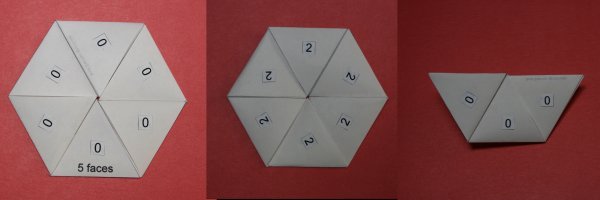The Slot Flex
|
The simplest hexaflexagon the slot flex works on is the 5-sided version. For reference, Iíll refer to the numbering on the braids page. The following steps work with any braid with five or more sides. Start with 0 on one side and 2 on the other. Fold it in half so there are three 0ís on each side.  Open up a pocket on either side so you have two pyramids joined by a common side, with all 3ís on the inside of one and all 1ís on the inside of the other.  Note that the shared side of the pyramids consists of two leaves. While looking at the inside of the pyramid with the 3ís on the inside, slide the single leaf with a 3 and a 2 on it through the slot between two sides of the pyramid.  You should now have a pyramid with three 3ís and a 0 on the inside with two tetrahedrons sticking off it. [Note that from here you could use the pyramid flex to explore further. See single slot flex for an example.]  Pivot the tetrahedron with the 1ís on the inside into the interior of the pyramid. Now push the leaf with the 0 and 1 on it through the same slot.  You should now be back to a state where there are two connected pyramids. One will have three 3ís and a 0 on the inside and the other will have 0, 3 and a pair of 4ís on the inside.  There are two different ways you can fold the 3330 pyramid flat. One way will then allow you to open the flexagon back up to a hexagon. One side of the hexagon will have four 4ís, 0 and 3. The other will have four 0ís, 1 and 2.  Single Slot FlexAfter you slipped the first leaf through the slot, you could instead do a pyramid flex and end up with interesting new configurations, including a pentagon with a tetrahedron sticking off one leaf. The pentagon can be flexed like a pentaflexagon. The following pictures show one such sequence. Larger hexaflexagons give more to explore. Even the 5-sided hexaflexagon has a dozen different pentagonal arrangements.  Here's the state diagram for the 5-sided hexaflexagon using the slot flex. Return to the Hexaflexagon page |
